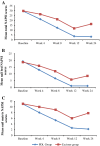Single Blinded Left-to-Right Comparison Study of Excimer Laser Versus Pulsed Dye Laser for the Treatment of Nail Psoriasis
- PMID: 24990703
- PMCID: PMC4257947
- DOI: 10.1007/s13555-014-0057-y
Single Blinded Left-to-Right Comparison Study of Excimer Laser Versus Pulsed Dye Laser for the Treatment of Nail Psoriasis
Abstract
Introduction: Nail psoriasis is relatively difficult to treat. Excimer laser has been approved for the treatment of psoriasis since 2000. Pulsed dye laser (PDL) in psoriasis therapy has shown good response rates, with extended remissions. This is the first study assessing both the excimer and PDL lasers in nail psoriasis.
Methods: In a comparison study, excimer laser versus PDL for the treatment of nail psoriasis was evaluated in 42 patients. The right hand nails were treated with excimer laser twice weekly and the left hand nails were treated with PDL once every 4 weeks, for total 12 weeks. The patients were then followed up after a further 12 weeks. Nail Psoriasis Severity Index (NAPSI) scores were recorded at baseline, weeks 4, 8, and 12, and then at week 24. Patients were also asked to grade the clinical response to each treatment.
Results: A total of 304 nail changes, 148 with excimer laser and 156 with PDL, were treated. The mean NAPSI score in nails treated with excimer laser was 29.8 at baseline, reduced to 16.3 at week 24. In PDL-treated nails, the NAPSI scores dropped from 29.5 at baseline to 3.2 at week 24. NAPSI improvement was significantly greater in PDL than excimer (P = 0.001; Wilcoxon signed-rank test). Thirty-four (81%) hands achieved NAPSI-50, and 23 (55%) achieved NAPSI-75 at week 12, while complete nail recovery was shown in 6 (14%) hands treated with PDL. Regarding the hands treated with excimer laser, only 16 (38%) hands achieved NAPSI-50, while no hands achieved NAPSI-75 at week 12. In general, subungual hyperkeratosis and onycholysis improved significantly, while nail pitting was least responsive. Oil drops and splinter hemorrhages showed moderate response.
Conclusions: When compared to excimer laser, PDL demonstrated a good response for treating nail psoriasis, with minimal side effects.
Figures


References
-
- Camp RDR. Psoriasis. In: Champion RH, Burton JL, Burns DA, Breathnach SM, editors. Textbook of dermatology, EDZ. 6. Oxford: Blackwell Science Publications; 1998. pp. 1589–1649.
-
- Samman PD, Fenton DA. The nails in disease. 5. London: Butterworth-Heinemann Ltd.; 1994.
LinkOut - more resources
Full Text Sources
Other Literature Sources

